China Eastern-Qantas & Air China-Air New Zealand JVs show renewed interest from Chinese airlines
The spectacular growth of China Southern Airlines in Australia and New Zealand came with the tradeoff that Air China and China Eastern lost interest in Australia and New Zealand, seeing China Southern's flood of capacity drastically hurting yields and making expansion too difficult. This is now changing, first with China's regulator signalling China Southern needs to slow its international expansion, and more recently with two proposed joint-ventures, one between China Eastern and Qantas and the other between Air China and Air New Zealand. The Chinese carriers are taking the view a deep partnership can help them where size is not to their advantage.
The two joint ventures are distinctly different. China Eastern will likely gain more from its partnership with Qantas while Air New Zealand can potentially gain more by having the JV mend its frayed relationship with Air China. Further, China Eastern's more ideally located Shanghai hub gives greater potential growth from the JV whereas Air China will be challenged with its northern Beijing hub.
Air New Zealand may ultimately need another mainland Chinese partner, with its existing Cathay Pacific JV also leaving room for more. Qantas is eager to portray the China Eastern JV being to Asia what its partnerships with American Airlines and Emirates are to North America and Europe. But Qantas still has much to do to address its Asian strategy.
Australia and New Zealand are more important to China Southern than to Air China or China Eastern
The impetus for these JVs, which await regulatory approval, is China Southern Airlines. Until 2010, China Southern was typically the smallest player in the China-Australia market with a marketshare of about 20% of carriers with direct seats (excluding sixth freedom operators). In 2010 China Southern commenced a strategy to make Australia and New Zealand a key market.
China Southern now holds a 42% share of seats in the China-Australia market. Australia is large feeder for New Zealand, but China Southern also claims the largest share of seats in the China-New Zealand market.
China-Australia direct seats by carrier: 2003-2013
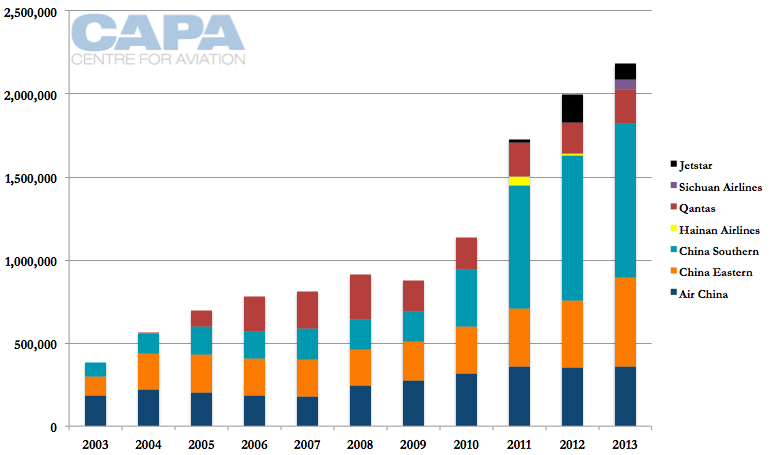
China Eastern and Qantas cite MIDT data showing China Southern has the largest share of the Australia-China market including sixth freedom operators. In the 12 moths to 30-Jun-2014, China Southern had a 27% share followed by China Eastern at 19%, Cathay Pacific at 17%, Air China at 13% and Qantas at 10%.
Share of China-Australia direct seats by carrier: 2003-2013
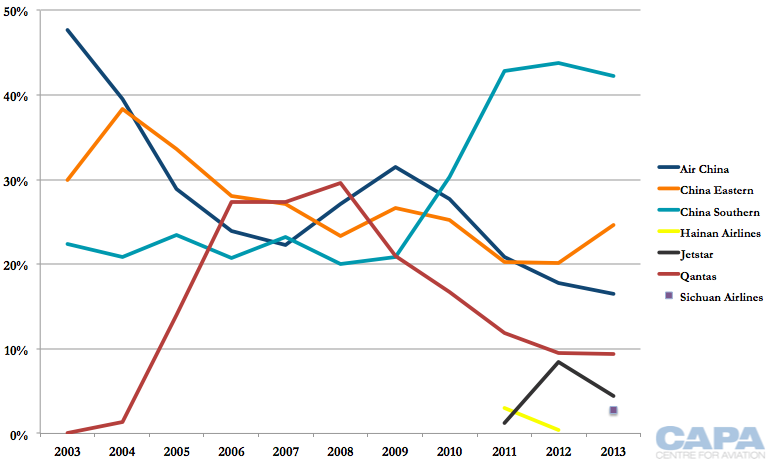
The reason for China Southern's build-up in Australia and New Zealand is that its hub in Guangzhou is geographically suited to Australia and New Zealand. Guangzhou is in southern China, enabling China Southern to funnel passengers across China down into Guangzhou and onwards to Australia and New Zealand. While Guangzhou may be good for Australia and New Zealand, conversely it is not strong for Europe and North American services. This is unlike Air China's Beijing or China Eastern's Shanghai hub. Further, those two hubs have stronger premium traffic, supporting long-haul flights.
China Southern is the largest Chinese carrier in Australia/New Zealand but the smallest in Europe and North America. In comparison, Air China is the strongest in Europe and North America while China Eastern is building up its long-haul network, especially to North America.
See related report: China Eastern Airlines seeks to revitalise its position with 777 long-haul growth and new brand
The graph below shows the differences in seat capacity by long-haul region. Looking at the same geographic split based on ASKs shows a wider disparity of how Air China and China Eastern are focused on Europe and North America. Those markets are further away from China than Australia, increasing ASKs.
Air China, China Eastern and China Southern one-way seats in main long-haul markets: 12-Jan-2015 to 18-Jan-2015
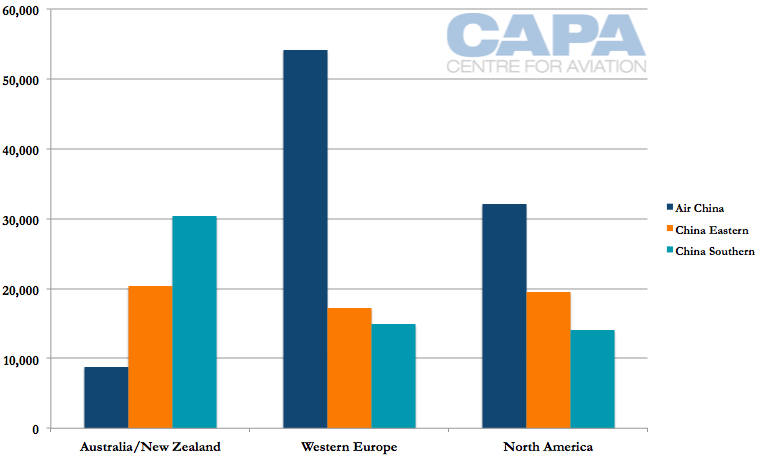
As much as Guangzhou is good for China Southern to serve Australia and New Zealand, Guangzhou also lacks strength to Europe and North America. China Southern has sought to conquer the Australian and New Zealand market, with size accompanied in Australia and New Zealand by heavy marketing and local event sponsorship. In the space of a few years, China Southern has nearly become a household name, one not as understood as Qantas or Singapore Airlines of course, but one that registers.
It is this presence that has shaped the JVs. The China Eastern-Qantas JV application states clearly: "China Southern's presence in the Australia-China market poses a real and effective competitive constraint" and that the JV application "is a competitive response by the Applicants to expansion by other rivals, particularly China Southern, on routes between Australia and China." Air China and Air New Zealand are not as close to each other as China Eastern and Qantas. As such, their application will not be submitted to regulators until 2015, they expect.
The JVs showed renewed interest in Australia and New Zealand from Air China and China Eastern, which were put off by China Southern's fast growth. China Eastern GM Oceania Kathy Zhang told the Sydney Morning Herald in Sep-2014 that "Our strategy is a healthy growth rate, unlike some other airlines. Some other airlines would like to put all of the capacity in the market to take traffic rights first." Ms Zhang did not directly reference China Southern, but the implication leaves no doubt. Ms Zhang foreshadowed a closer relationship between China Eastern and Qantas.
China's regulator, the CAAC, has put brakes on China Southern in Australia. The CAAC is unwilling to expand the Australia-China bilateral while yields in the market remain low, deterring others from entering or growing. This will also help address China Southern's weak international performance.
See related report: China Southern Airlines, now with 600 aircraft, has a weak 1H2014 and faces new challenges
Qantas' gain from China Eastern JV is still limited
Qantas is disadvantaged in serving China. Although it lacks an ability to access beyond gateway cities, this can and has been addressed by onward codeshares. The larger challenge is Qantas' cost base, not just high, but also high in comparison to Chinese carriers.
This ultimately will limit its potential on long-haul flying. Qantas' situation in China with the current Chinese tourism influx contrasts to Australia's previous tourism influx, from Japan in the 1990s and 2000s. But during this period Qantas had the upper hand as its cost base was lower than that of Japan Airlines. As CAPA previously wrote:
In 2005 Qantas' CASK was about USD5 cents lower than JAL but in 2013 about USD2 cents higher than China Southern. These figures do not take into account average sector length. China Southern is primarily a short-haul operation, which is most cost-intensive than Qantas' more balanced short- and long-haul operations. Adjusting for this would further give China Southern an advantage. As for the future, China Southern is largely inefficient and has yet to undertake a serious cost-cutting programme. When this inevitably occurs, its cost base will be further lowered.
JAL 2005, Qantas 2005, Qantas 2013 and China Southern 2013 CASK comparison (USD)
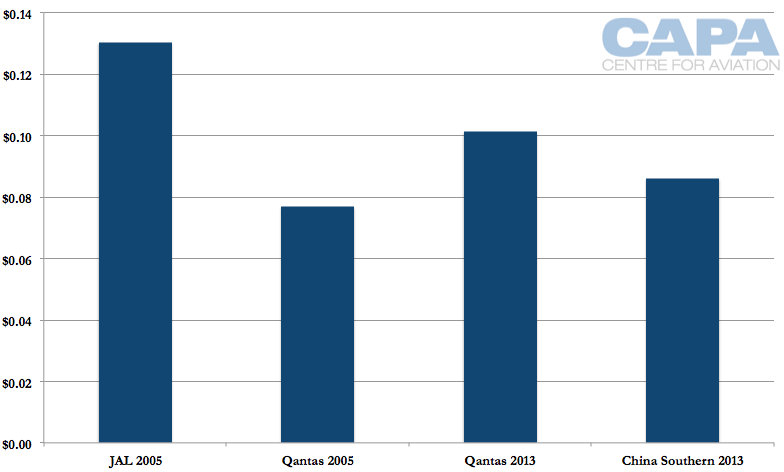
See related report: Qantas dominated 1990s/2000s tourism boom from Japan, but is disadvantaged in current Chinese influx
Qantas argues that without the JV it is likely to see "increased marginalisation". It is true, as explained above, Qantas cannot keep up with the growth from China to Australia; it lacks the cost base and will in the foreseeable future be at a disadvantage to Chinese carriers. But even a JV is unlikely to reverse this. China Eastern and Qantas mooted new routes the JV could open, but China Eastern appears likely to do all of the flying and may have opened those routes anyway.
The benefit of the JV to Qantas is expanding its virtual presence, the long-haul strategy of Virgin Australia. "Without access to sufficient capital to profitably expand its own operations, Qantas needs to collaborate with a local partner in order to leverage network benefits and distribution strength", the carriers state. Qantas unsurprisingly says its Shanghai route is currently not meeting its cost of capital.
The Qantas-China Eastern codeshare agreement dates back to 2008 and comprises hardblock and freesale components. The two do not state why they are unable to expand the codeshare, which would bring some of the benefits of the JV.
China Eastern and Qantas codeshare details: Nov-2014
| China Eastern-operated | Qantas-operated | |
| Hardblock | Melbourne-Shanghai | Sydney-Shanghai |
| Freesale |
Singapore-Shanghai Domestic China - |
- Singapore-Brisbane/Melbourne/Sydney Domestic Australia Trans-Tasman |
| No codeshare | Sydney-Shanghai |
China Eastern and Qantas make repeated references to the JV allowing Qantas "to better align its product offering to demand characteristics...to offer a product proposition that is better aligned with the predominantly leisure-oriented and student passenger base out of China". It is unclear how these product offerings can be improved by the JV. The product offering seems to imply lower-cost capacity, which could be accessed with a deeper codeshare.
An expanded codeshare relationship would not permit coordination of pricing, capacity and sales and marketing. But Qantas is unlikely to be a major player in this market, meaning it has little to coordinate. This is unlike the Qantas-Emirates arrangement where Qantas flies (typically) two daily A380s to Dubai versus one A330 to all of mainland China. By Qantas' own admission - that it cannot "profitably expand its own operations" - its future growth in mainland China seems slim. Further, Qantas' customer base is distinctly different to China Eastern's. Qantas' customers are more corporate heavy and are willing to pay a premium for Qantas whereas China Eastern generally sells on price.
Qantas notes that group bookings account for up to 20% of passengers on its Sydney-Shanghai route and during some times of the year it is unable to take group bookings. Qantas argues the JV could enable it to place those passengers on China Eastern. But once again it is unclear how an expanded codeshare relationship could not sufficiently cover that. Further, group bookings are often the lowest-yielding.
Qantas and China Eastern state that if the JV is approved, Qantas will move from terminal two in Shanghai Pudong to China Eastern's terminal one, a convenience to the benefit of passengers. They state that without the JV: "the Applicants have no commercial incentive to co-locate terminals in Shanghai". However this is contradicted by the benefits they state that will come from co-location: the minimum connection time will decrease from 2.5 hours to 1.5 hours - a significant saving.
Co-location will give China Eastern and Qantas a faster Sydney-Shanghai-Beijing total trip time (13h40m) than Cathay Pacific via Hong Kong (13h45m) and also give access to 56 additional connecting frequencies. These are very real commercial incentives that come simply by co-locating and not having a JV. Qantas also notes the lounge it uses in Shanghai terminal two is "inferior" to China Eastern's lounge in terminal one, a further incentive to move terminals whether or not a JV is in place.
Connections available to Qantas passengers between Sydney and mainland China: Nov-2014

Qantas appears to risk giving away substantial access and know-how for little in return. Many gains could be achieved without a JV. The China-Australia market will grow rapidly in coming years. The justification for a JV may be greater in the future than present.
China Eastern likely to gain more from Qantas JV
While there can be gains to Qantas from a JV with China Eastern, it is China Eastern that will likely benefit the most. At the top level, a stronger China Eastern can balance China Southern, although Qantas also codeshares with China Southern while China Eastern and China Southern are friendly towards each other.
See related report: Qantas and China Southern Airlines to partner, clawing back at gains from Cathay Pacific & SIA
At more nuanced levels, China Eastern has envied the corporate traffic and premium yields Qantas fetches. Both operate between Shanghai and Sydney at similar times with A330s but Qantas' revenue is far richer. While China Eastern has lacked on product, it is changing this, with some A330s featuring direct aisle access for every seat in business class, introducing this before Qantas.
China Eastern and Qantas cite ABS data showing that between Australia and China Qantas in the 12 months to Apr-2014 has a higher share of business travellers (21%) than its overall share (15%) while China Eastern has a lower business traveller share (9%) than its total passenger share (14%). Coordination made possible under the JV will give China Eastern valuable experience how to become more sophisticated and competitive. The immediate benefit is in the Australian market but with time will be deployed across China Eastern's global network. This is the knowledge and learning Chinese carriers seek from international partners. China Southern is learning from Delta while Air China is learning from Cathay. A growing number of JVs - such as those from Air China with Lufthansa, Air Canada and now Air New Zealand - will further its knowledge.
The application states China Eastern needs "additional product and service expertise", "to attract and retain increased numbers of premium passengers" and that the JV "will enable China Eastern to build on Qantas' domestic business and frequent flyer proposition by accessing high-yielding Australian domestic corporate and government travellers".
Combined with a deeper reach into Qantas frequent flyer programme, these statements equate to Qantas giving away - or lending - the crown jewels to a chosen partner. This in itself is not necessarily problematic. Qantas' enviable position in Australia - reach and yield premium - was what made Emirates interested in Qantas. Likewise for Etihad partnering with Virgin Australia.
Qantas is passing over traffic it cannot carry because of its higher cost base and limited reach. Picking up the downside are competitors, namely Cathay Pacific and to a lesser extent Singapore Airlines. If Qantas cannot carry traffic, it may as well direct it to an airline it is friendly with and will hope to receive something (likely less) in return. Not partnering closer with China Eastern would see a continued benefit to Cathay and Singapore Airlines. Those two compete with Qantas across a network far broader than mainland China, in addition to SIA partnering with and partially owning Virgin Australia while Cathay is no friend to Qantas and is doing everything it can to block Jetstar Hong Kong, which Qantas Group has a minority stake in. But this benefit to Qantas does not necessarily mean consumers benefit.
Qantas and China Eastern flag new routes from JV. China Eastern is most likely to operate them
If the JV is approved, services from Brisbane and/or Perth to Shanghai are likely to be opened, but these could be opened without the JV. China Eastern would likely open Brisbane and Perth, which it does not serve but China Southern does. The two also flag expanded frequency that would see China Eastern operate 24 flights per week between Sydney and Shanghai (up from 17 per week in northern winter 2014) and 22 flights per week between Melbourne and Shanghai (up from 14 per week in northern winter 2014).
Qantas and China Eastern Australia-China Operations: Northern Winter 2014
|
Operating Carrier |
Route |
Schedule |
|
|
Daily (depart 1050, arrive 1830) Daily (depart 2005, arrive 0940) |
|
|
|
Daily (depart 1200, arrive 1920) *Daily (depart 2130, arrive 0500) Daily (depart 2020, arrive 1000) *Daily (depart 2355, arrive 1335) Daily (depart 1200, arrive 1920) *Daily (depart 2230, arrive 0605) Daily (depart 2015, arrive 1000) *Daily (depart 2355, arrive 1340) 3pw (depart 1130, arrive 2325) 3pw (depart 1550, arrive 0930) |
This amounts to significant expansion from China Eastern, making it a closer competitor to China Southern. But again it is unclear if China Eastern would grow to this size without the JV. China Eastern and Qantas say "The Australia-China air passenger services market is characterised by low barriers to entry and expansion". But the swift exit of Hainan Airlines and difficulties faced by Sichuan Airlines suggest the market is more difficult than they make it out to be. A stronger China Eastern could make it more challenging for a future entrant.
See related report: Sichuan Airlines grows with Chongqing-Sydney service, but European and American expansion awaits
China Eastern and Qantas want to implement the JV in Jun-2015 in advance for the busy northern winter 2015 period.
China Eastern JV is valuable - but far from a silver bullet for Qantas. More work in Asia awaits
Qantas sought to convey that the China Eastern JV would join its American Airlines and Emirates partnerships. But if approved the China Eastern JV would remain small in at least the medium-term. There should be no mistaking that, for the time being, the JV will have limited impact across Qantas' Asian network. Mainland China is a small part of Qantas' Asian network compared to far larger capacity deployment to Hong Kong and Singapore. Qantas' mainland China capacity is about 15% the size of Qantas' seat exposure in Hong Kong and Singapore, markets that suffer from low yields. The China Eastern JV will not address those.
Qantas international seat capacity by country/territory: 12-Jan-2015 to 18-Jan-2015
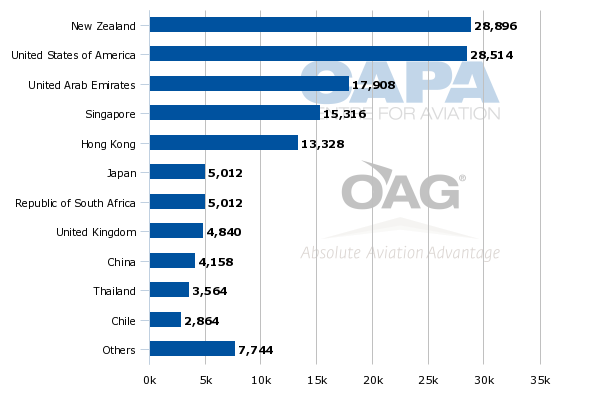
Air New Zealand and Air China relationship remains distant. A JV can help to mend
The China Eastern-Qantas JV announcement was followed a few days later by Air New Zealand and Air China announcing their own JV. But this one is not as far advanced, with Air New Zealand and Air China still to discuss terms and then submit an application in 2015; China Eastern and Qantas have already submitted an application. Some of Air China's other recent JV announcements - with Lufthansa and Air Canada - also indicated a slow time frame, showing Air China's slow speed, surely due to government interference with the flag carrier.
See related reports:
- North American aviation grows closer to China: Air Canada-Air China JV, US liberalises China visas
- Air China-Lufthansa Group JV will control 35% of Europe-China market while easing growth tensions
Air China and Air New Zealand are not as close as Qantas and China Eastern. Air New Zealand was not happy that Air China did not provide sufficient codeshare arrangements to sustain Air New Zealand's service from Auckland to Beijing, Air China's hub. Under the proposed framework, Air China will launch Beijing-Auckland services but Air New Zealand will keep Shanghai-Auckland as its sole mainland Chinese route. Air China will enter New Zealand after China Southern and China Eastern.
Air New Zealand's frustrations with not having a solid partnership with Air China are hinted at in a statement from CEO Christopher Luxon: "China remains a challenging market for us to operate to. Working with a strong, well respected home market carrier like Air China would give us a huge opportunity to convert this potential growth, while jointly offering the additional capacity to support it."
The Air China JV would follow Air New Zealand's JVs with Cathay Pacific and Singapore Airlines. The Air China JV shows Air New Zealand has found limited success with the Cathay partnership. But Air New Zealand may still need yet another Chinese partner.
Part Two of this report will look at the growth in the China-New Zealand market.